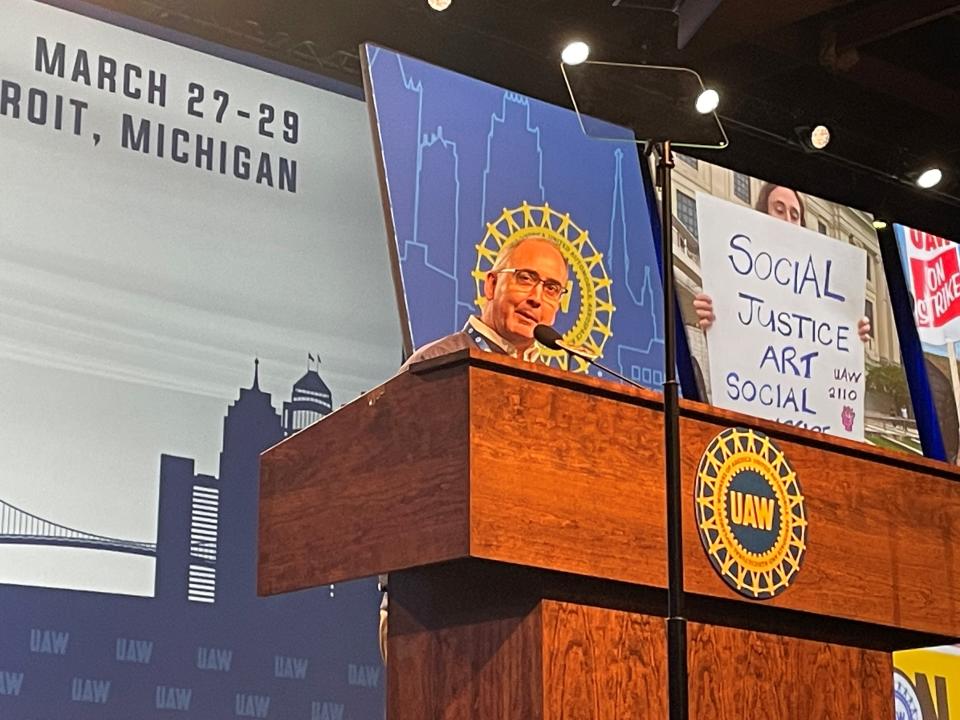How UAW's transforming itself ahead of contract talks with automakers
The UAW will take a new direction under a new and relatively unknown leader after what's been a turbulent few years as the union emerges from a scandal and enters a new era of unifying to fight for a new contract with Detroit automakers.
For the first time, the UAW has a leader elected by the rank-and-file. On Saturday, Shawn Fain was declared the winner over incumbent President Ray Curry in a runoff election. On Sunday, Fain was sworn in and the next day he took to the podium at the union's bargaining convention in Detroit to declare it is "a new day in the UAW." Fain said the union must present a united front after the divisive election and when it comes to contract talks this year, the union will be ready to fight for more gains.

More:UAW to bring militant negotiations like Detroit Three haven't seen in years, experts say
Here’s background on where the UAW stands today.
Why are there two factions in the UAW?
For more than 70 years, the UAW had one group in charge. That group, which came to be known as the administration caucus, oversaw a growing union that was able to deliver for its members in the years when the domestic auto industry was the undisputed king. In recent decades, however, the caucus was in charge as the domestic auto industry faced increased competition from foreign automakers and a reckoning during the financial crisis that led the union to agree to concessions such as tier wages. Efforts to challenge the administration caucus gained momentum after a corruption scandal, involving the misuse of millions of dollars of worker training funds and dues money. The scandal sent former top union officials and auto executives to prison. The union avoided a federal takeover by agreeing to reforms that included a referendum — which a dissident group known as Unite All Workers for Democracy championed — on the way the union picks its top leaders. That dissident caucus increasingly began to challenge the administration caucus, and with the success of candidates associated with Unite All Workers for Democracy in the recent election, the union now has two clear factions operating.
How was this election different from previous years?
This was first time the UAW membership chose its leaders in a direct election, which reform advocates pitch as more democratic. Previously, delegates from UAW locals chose the union’s leaders at its conventions. Delegates from union locals are still part of the nominating process, and they play a big role in the current special bargaining convention by voting on the resolutions that will come out of the convention. The election, which was overseen by an independent, court-appointed monitor as a result of the agreement with the government, included two slates of candidates, one supported by the dissidents and one supported by the administration caucus, as well as a number of independent candidates.
How were the two main candidates viewed?
Automakers saw Curry as someone with whom they had developed a working relationship. Some union members, including some rank-and-file, viewed him as an experienced negotiator and stable leader who was instrumental in helping to move the union forward after the scandal. But others in the rank-and-file thought Curry was too chummy with the establishment and would not push hard enough to get what the workers want.
Fain, who ran atop the UAW Members United slate, has been largely viewed as a renegade of sorts because he has preached reform and openly declared his plan to be aggressive in contract talks. In a draft memo written by Fain's staff, obtained by the Free Press, there are multiple references to a strike.
But some in the rank-and-file say Fain is just as much aligned with the establishment as Curry, noting Fain was an administrative assistant to the UAW vice president over the union’s Stellantis Department. Fain served 10 years as a UAW international representative and was a former skilled trades committeeperson and shop chair at what's now the Stellantis Kokomo Casting Plant in Indiana.
Has the union united?
Some union leaders are confident members will come together in time. One UAW delegate, who asked to not be named because he is not authorized to speak to the media, said that most of those in his region voted for Curry, so "it will take time and proper IUAW leadership to be able to bring everyone together. I believe it is very much a wait-and-see mentality with many feelings of uneasiness as to what happens now?"
Why is all this important now?
The UAW's contract with the Detroit Three automakers expires in September, but initial negotiations will start soon. Fain is an unknown to many auto executives and judging from his platform, the relationship won't be easygoing. For example, in a January interview he alluded to Stellantis as being "a bully." He plans to overhaul the union's staff and processes. If he calls for a strike later this year, industry experts pin the target on General Motors or Stellantis. But two high-ranking UAW officials told the Free Press a strike could involve all three Detroit automakers. Those people asked to not be identified for fear of repercussions for divulging internal discussions.
More:Bob King once led the UAW, but he hasn't stopped thinking about its future
Contact Jamie L. LaReau: jlareau@freepress.com. Follow her on Twitter @jlareauan. Read more on General Motors and sign up for our autos newsletter. Contact Eric D. Lawrence: elawrence@freepress.com. Become a subscriber.
This article originally appeared on Detroit Free Press: How UAW's transforming itself ahead of contract talks with automakers

 Yahoo Autos
Yahoo Autos 